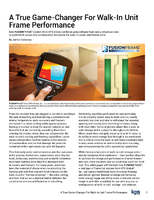ASTM Standard addresses rolling friction measurement.
Press Release Summary:
Part of ASTM International Committee G02 on Wear and Erosion, Subcommittee G02.50 on Friction developed standard G194, Test Method for Measuring Rolling Friction Characteristics of a Spherical Shape on a Flat Horizontal Surface. Standard will have applications in variety of factories, on artificial turfs and playing surfaces, and even in classroom. Test can be used for quality control of balls and for investigating surface finish and other effects on rolling resistance.
Original Press Release:
Measuring Rolling Friction Is Purpose of New ASTM Wear and Erosion Standard
W. CONSHOHOCKEN, Pa., 29 January 2009-A new ASTM International standard will have applications in a variety of factories, on artificial turfs and playing surfaces, and even in the classroom. The new standard, G194, Test Method for Measuring Rolling Friction Characteristics of a Spherical Shape on a Flat Horizontal Surface, was developed by Subcommittee G02.50 on Friction, part of ASTM International Committee G02 on Wear and Erosion.
"Interlaboratory tests were conducted on bearing balls rolling on precision surface plates," says Ken Budinski, technical director, Bud Labs, and chair of G02.50. "These tests clearly showed the effect of the nature of the ball, the nature of the rolling surface and contaminants on the rolling friction of hardened steel balls on precision flat surfaces." The test can be used for quality control of balls and for investigating surface finish and other effects on rolling resistance.
Other industrial applications for G194 include rolling surfaces for classification of produce and for spherical food products such as candy, as well as for the feeding of parts that are spherical or nearly spherical in shape. Ball manufacturers, makers of food processing equipment and those interested in sports and games applications will be the primary users of G194, according to Budinski.
In addition to these industrial applications, Budinski says that the test in G194 requires "student-proof" equipment, which would make it very suitable for teachers in demonstrating the principles of rolling friction. Because reducing the rolling resistance of vehicles (by proper tire inflation and tread design) can save fuel, the subcommittee would be particularly interested in hearing from automobile and tire manufacturers on their interest in expanding the G194 rolling resistance concept to wheeled vehicles.
With the approval of G194, Subcommittee G02.50 is turning its attention to a proposed new standard, WK20099, Guide for Determining Friction Energy Dissipated in Reciprocating Tribosystems. Interested parties are welcome to join in the development of this proposed standard as well as in discussions of future revisions to G194.
For technical Information, contact Ken Budinski, Bud Labs, Billerica, Mass. (phone: 585-225-6529; kenbudinski@hotmail.com). Committee G02 meets June 24-25 in Norfolk, Va.
ASTM International welcomes and encourages participation in the development of its standards. ASTM's open consensus process, using advanced Internet-based standards development tools, ensures worldwide access for all interested individuals. For more information on becoming an ASTM member, please contact Kate McClung, ASTM International (phone: 610-832-9717; kmcclung@astm.org).
Established in 1898, ASTM International is one of the largest international standards development and delivery systems in the world. ASTM International meets the World Trade Organization (WTO) principles for the development of international standards: coherence, consensus, development dimension, effectiveness, impartiality, openness, relevance and transparency. ASTM standards are accepted and used in research and development, product testing, quality systems and commercial transactions around the globe.




